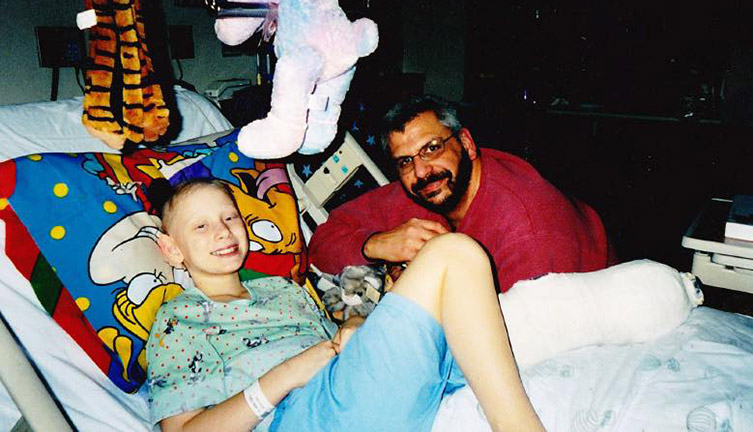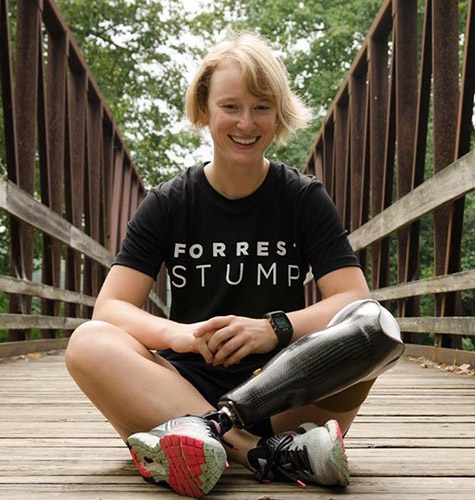8 Years Old at Diagnosis
Nicole Ver Kuilen, 26, has always been on the move. A lifelong athlete, she hasn’t let the setbacks of childhood cancer and a leg amputation stop her from living an active lifestyle. And today, she is running, swimming, and biking down the west coast to raise awareness for a cause dear to her heart.
At eight years old, the Chanhassen, Minn., native sprained her ankle after tripping and falling on the way to a softball game. Doctors ordered an x-ray to ensure that she had not broken any bones. What they discovered would change Nicole’s life forever. “They found an egg-sized tumor in my left tibia bone,” she says. “This was quite a miracle. I hadn’t had any pain or issue with my leg otherwise.” Cells from the tumor were sent to various oncologists, who were split on whether it was benign or malignant. Doctors decided to monitor the growth for changes. It wasn’t until Nicole and her family moved to Rochester, Minn., two years later and re-established her care at the renowned Mayo Clinic that they received an answer: The tumor was malignant – an aggressive form of osteogenic sarcoma.

Nicole’s chemotherapy program was part of an ongoing clinical trial at Mayo Clinic, which allowed oncologists to learn more about osteosarcoma (bone cancer) while administering potentially life-saving treatment. She was one of 100 other cancer patients around the country undergoing the same protocol: 18 rounds of chemotherapy over the course of nine months, including doses of Adriamycin.
“The hope was that within a few months of aggressive chemotherapy, the tumor would shrink enough to be safely removed and that I could avoid amputation,” she says.
However, the tumor maintained its size, and her left leg was amputated below the knee. After receiving a customized prosthetic leg a couple of months later, Nicole slowly regained her strength, working her way from a wheelchair, to crutches, to a cane. “Six months after my amputation and once chemo was over, I was able to walk on my own. That fall, my parents enrolled me in soccer, and I started running and playing with kids my age again,” she says. “But it took years to regain a sense of confidence in my ability and to not make excuses for my leg.”
It was a varsity softball coach who challenged Nicole not to be held back by what others perceived as a disability: “She didn’t let me get away with anything, and she still expected a lot out of me. I started running and being a lot more physically active and athletic. This was huge for me.”

As a business student at the University of Michigan, Nicole ran 5K and 10K races. “I started placing in my age group and realized I was good at this. Then I started to get into triathlons. I also did cross-country skiing during the winter,” she says.
Nicole had been pushing her body – and her prosthesis – to the limits. After her insurance denied coverage for waterproof legs and activity-specific prosthetics (such as the running blades worn by Paralympic sprinters), she decided to test the capabilities of her original prosthesis, which was designed only for walking and light jogging. The unamputated right side of her body bore the brunt after years of marathons, open-water swims, and long-distance cycling, leading to physical asymmetries. “My basic prosthetic device was not designed to take on this load,” she says.
Basic prosthetics typically last three to five years, and in Nicole’s case, insurance covered a percentage of the cost. However, this spring, with the help of a special grant, a determined Nicole hired personal trainers to help build strength on her left side. Through this experience, she learned just how many amputees are facing similar struggles. “Incredible technology exists for amputees, but most do not have access to it,” she says. With this, she found an opportunity to incite change. Nicole left her alumni relations job at the University of Michigan and hit the road, embarking on a 1,500-mile trek to raise awareness about access to prosthetics for amputees.
With a team that includes a documentary film crew, her mother Jan Harley, friend Kathleen Wang, and prosthetist Natalie Harold, Nicole is swimming, biking, and running from Seattle to San Diego on what she calls the Forrest Stump Journey.

“I created Forrest Stump to raise awareness about the barriers that stand between amputees and the prosthetics they need,” she says. “I am and will continue to be, an advocate for legislative changes that raise the standard of care for amputees.”
“We need to leave our human interests at the door and do what’s in the best interest of our kids,” she said. Which is why she has partnered with CureSearch on this story, she knows just how critical these conversations are for making a real impact.
Nicole wants to inspire others – whether for cancer research or amputee rights – to use their gifts for good: “Take time to think of your bigger purpose. What injustices can you help solve before you go? What unique voice do you have to offer the world? Then stand up and say something. Use your talents for something bigger.”
Want more stories like this?
Get emails that matter, when it matters.
